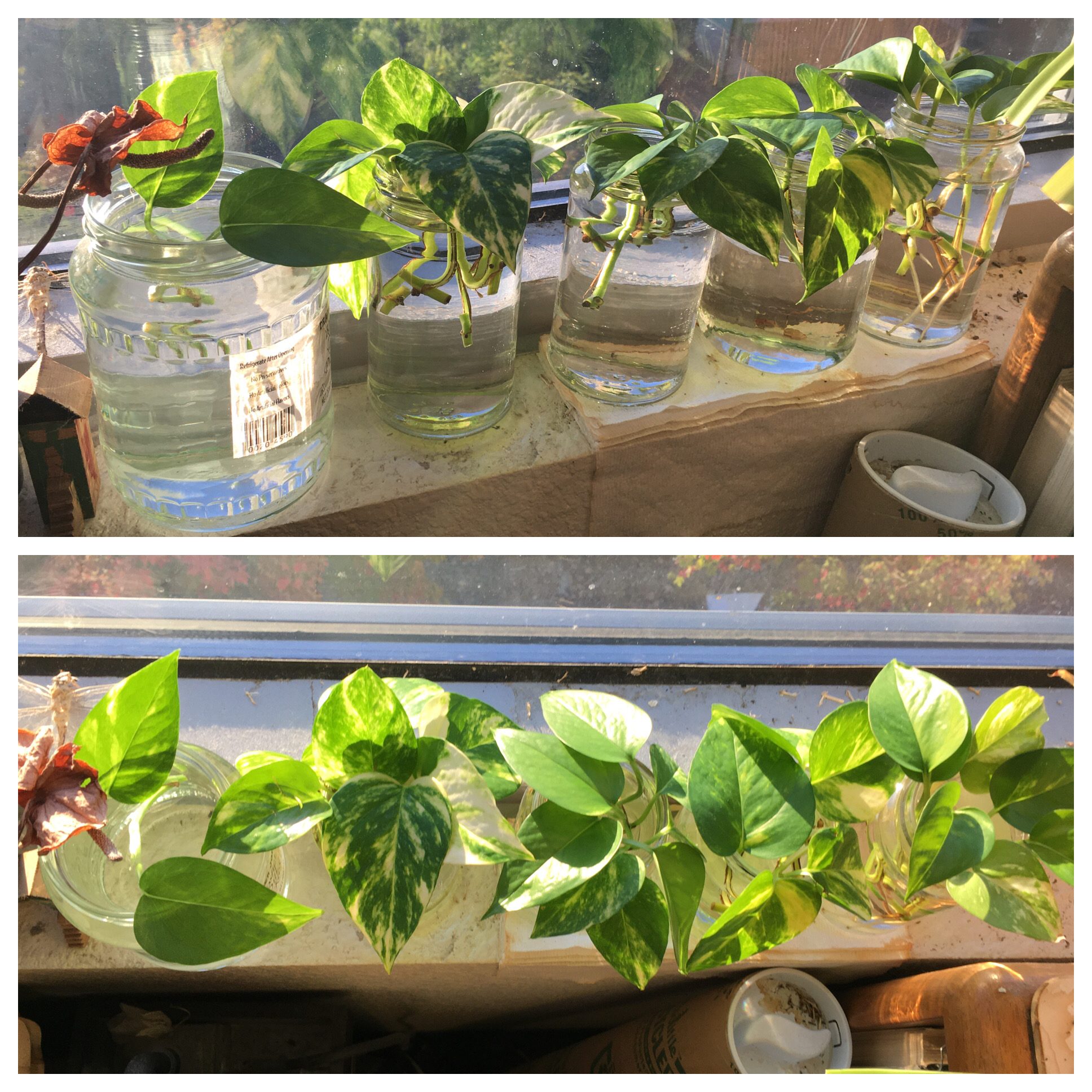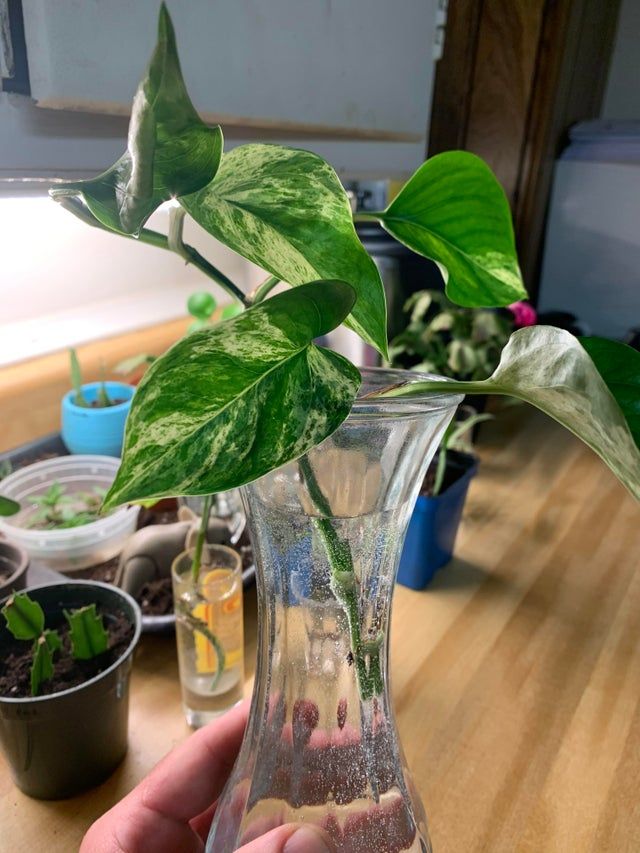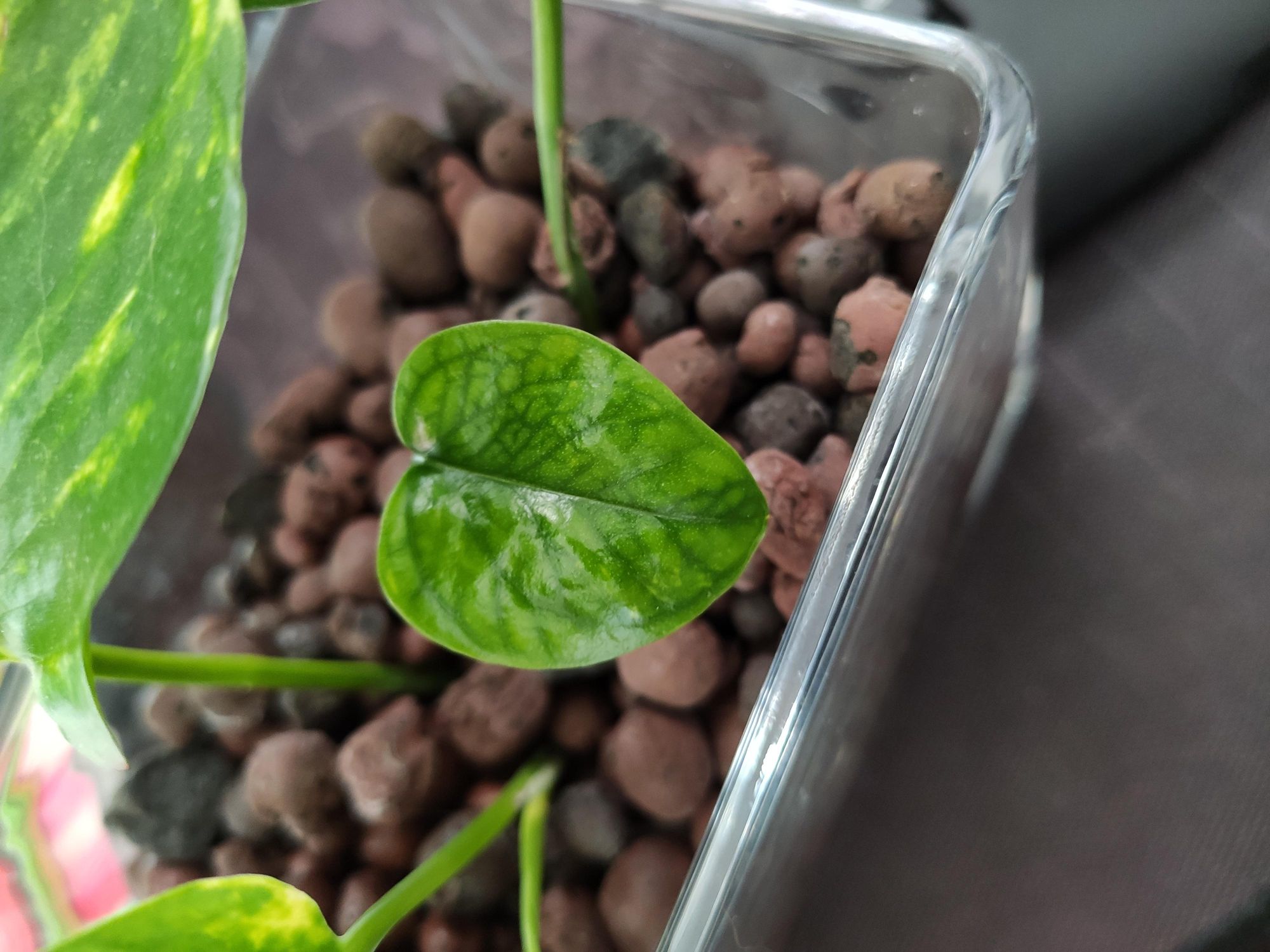Propagating Pothos in Water & Grow Mediums

As any houseplant lover knows, pothos plants are one of the easiest plants to propagate. In fact, they are so easy to multiply that they are considered invasive in the wild. However, plant parents sometimes get frustrated when they are not always successful with their propagation.
This is because mishaps tend to happen during pothos propagation. One common problem is that their cuttings tend to turn yellow and rot before they can form roots. If this happens to you, don't panic, it's not your fault - it's a numbers game and sometimes you roll the wrong dice during propagation.
One of the main misconceptions with water propagation is that you can just cut off the leaf and put it in water. In reality,what you need is called the leaf node, which attaches the leaf to the vine. The easiest way to collect them is to cut off a vine, then trim all the excess between each node, leaving about a half cm on each side.
Not All Pothos Will Propagate at the Same rate.
Epipremnum and philodendron pothos have faster rates of growing roots and successfully propagating compared to scindapsus pothos, which typically are much slower growers and their cuttings do not always successfully propagate.
So if you have a Scindapsus Pothos, then you should factor in the higher chances of a failed propagation before going ahead with it. The good news is that there are a few things you can do to increase your success rate. To have better success in propagating any pothos, it is best to start from a healthy plant.
This does not mean that you can't save ailing plants via propagation, it just means that the success rate will vary. The more "sick" your Pothos plant is, the less likely you are to see a succesfull propagation.

When taking Pothos cuttings, it is best to look for vines where the leaves have already fallen off
This is because the vine will be less likely to lose additional leaves when cut near a leafless node. In addition, cutting near a leafless node will help to prevent waste, as the cuttings can be rooted in water or potting mix without losing any leaves. As a result, taking cuttings from Pothos vines that have already lost some leaves is the best way to ensure minimum leaf loss and maximum propagating success.
Cutting a long Pothos vine to propagate can be difficult, but it’s not impossible. The first step in preparing for this process is cutting the vine into smaller pieces and making sure each piece has one more node than leaves on its original branch or stem (for example: if an individual leaf had two nodes then you would need three).
This might mean having to cut off leaves in order to expose a node in the pothos cutting. When decided on the vines to propagate from, cut about a quarter to a half inch away from both sides of the node at a forty five degree angle.
Cutting too close or far from the node can have a significant effect on how well cuttings will propagate. If there is too much stem, it'll likely rot before new roots and leaves develop, on the other hand if there is not enough stem there will be little to no space for the cutting to grow new roots and new leaves.
Pothos plants can be propagated by single leaf cuttings,(one leaf, one node) but this poses higher risk because they're more likely to die before growing roots.
This is because the root system of a pothos plant is what provides the majority of the nutrients for the plant. So If a pothos only has one single leaf, then it is not able to photosynthesize enough to provide the nutrients that the roots need. The roots will begin to die, and without roots, the pothos will not be able to take in water or nutrients from the soil.

Pothos are easy to propagate in water, making them a great plant for beginners.
Pothos are commonly propagated in water, but there are a few things to keep in mind.
1. Make sure you use a Dark Container
If you want your pothos to grow well, it is best to use a dark colored container instead of a clear one. Roots grow better in the dark than in the light, so using a dark colored container will help promote more robust growth. If you must use a clear container, be sure to place it in a spot where it will not be exposed to too much light.
2. Pothos need warm temperatures in order to start growing roots.
The ideal temperature for pothos is 68 degrees Fahrenheit or 20 degrees Celsius. If the temperature is too cold, pothos will not be able to start growing roots. In order to prevent this, do not put pothos by the window sill when it is cold outside. Instead, use a heat mat to help speed up root propagation. By using a heat mat, pothos will be able to start growing roots even when the temperature is cold. As a result, pothos will be able to grow and thrive in any environment.
3. Change the water regularly
In nature, pothos receive oxygen from the air around them. However, when pothos are kept in water, they must rely on the oxygen dissolved in the water. Over time, pothos cuttings will use up the oxygen in the water as they try to grow new roots. As a result, it is important to change the water regularly instead of simply topping it off when the water level goes down.
4. Make sure you transfer your Pothos cuttings on time!
When to transfer cuttings into soil is a bit tricky. You want the roots of your new plants developing well in water before you put them in soil. but it's important not to keep them in water for too long. If you let the roots grow too long in water, they'll develop a different structure that's more suited for processing oxygen in water instead of in soil. This can be a problem when you try to transplant them into soil, because the roots won't be able to absorb nutrients as effectively. As a result, your plant may become stunted or even die.
Propagating Pothos in Grow Mediums
If this is your first time hearing of Grow mediums, here's a brief definition: Grow mediums are soil like materials that help support the plant as it grows. The most common grow medium is soil, but there are other options such as coco coir, LECA perlite, and sand.
Grow mediums provide a number of benefits for plants. They help support the plant, provide nutrients, and retain water. They also provide drainage and aeration, which are important for plant health.
While pothos can be propagated in water, more success is often found when using grow mediums such as soil or LECA. This is because pothos roots more easily in these mediums, leading to healthier plants overall. In addition, using grow mediums helps to prevent the spread of diseases, as pothos cuttings are less likely to contract diseases when placed in sterile conditions.
When pothos cuttings in water are transplanted into soil, more often than not, the cuttings experience severe shock transplant and then die when repotted in soil.
Propagating pothos in grow mediums helps it to develop a root system better suited for survival once transplanted into soil.

When propagating in grow mediums, here are a few things to keep in mind:
1. Sterilize your planting materials
One of the most important things to consider when propagating pothos in grow mediums is sterilizing your planting materials. This is especially important if you're using coco coir or sphagnum moss. The best way to sterilize these materials is to rehydrate them with boiling water. This will kill any eggs that are present, and help to prevent a fungus gnat infestation in your pothos plants.
2. Get rid of excess moisture in your Grow medium
Once you have rehydrated your coco coir or sphagnum moss, it is important to squeeze out as much water as possible before using it to wrap your pothos cuttings. Excess moisture can lead to rot, so be sure to wring out the moss or coco coir until it is only slightly damp. Then, simply wrap the cutting in the moss or coco coir, being sure to cover the entire cutting. Once wrapped, the cutting can be inserted into a container of fresh potting mix. The coco coir or sphagnum moss will help to keep the cutting moist and promote root growth.
3. Use a container without drainage holes for your Grow Medium
If you're using perlite, LECA or another similar medium to start your pothos cuttings, it's important to use a container without drainage holes. This will help prevent the roots from drying out too quickly. Instead, fill the container with water up to the level where it reaches only the bottom third of the inert medium. The water will then reach the cuttings through capillary action. By keeping the roots moist but not waterlogged, you'll encourage healthy growth and ensure that your pothos cuttings take root successfully.
A Common Pothos Propagation Mistake
Pothos propagation is a simple and rewarding process, but one that requires a little patience. One mistake that is often made is potting the new propagations with the mother plant. This can lead to problems for both the mother plant and the new propagations.
The mother plant may develop root rot from being watered too frequently to accomodate the new pothos, or the new propagations may fail to adapt to the drier soil environment and starve.
For best results, pot the new propagations separately and allow them to establish themselves before combining them with the mother plant. With a little patience, you will be rewarded with healthy plants that will thrive for years to come.
Key Takeaways
-
Making Pothos cuttings is a tricky business. Have an extra few nodes on hand, just in case things don't go according to plan.
-
The best way to encourage fast, healthy root growth when water propagating Pothos is by using a dark container and making sure the temperature stays warm.
-
During the cutting process, you might come across nodes without leaves. Don't throw them away! What you can do instead is stick these nodes onto the soil of your mother plant (yes -the one from which they came) and care for it as if it were a normal pothos. Overtime, these nodes will start shooting new leaves. It doesn't always work, but when it does.. it really does.